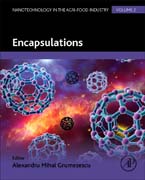
Encapsulations: Nanotechnology in the Agri-Food Industry Volume 2
Grumezescu, Alexandru
Encapsulations: Nanotechnology in the Food Industry, Volume 2, serves as a helpful guide to the use of nanoencapsulation in the food industry for fermenting food, promoting food stability, and producing antimicrobials for food safety and quality. This novel approach also provides barriers between sensitive bioactive materials and the environment to allow taste and aroma differentiation and to mask bad flavors or smells, increases the bioavailability of food ingredients, improves the solubility of poorly water-soluble ingredients, enables higher ingredient retention during the food production process, and increases shelf life. This book covers nanotechnology in encapsulation for food applications, nanoencapsulation processes, and materials used in nanoencapsulation, and also assesses which applications are most beneficial to the food industry. Includes the most up-to-date information on nanoencapsulation and nanocontainer-based delivery of antimicrobialsPresents nanomaterials for innovation based on scientific advancements in the fieldProvides control release strategies to enhance bioactivity, including methods and techniques for research and innovationProvides useful tools to improve the delivery of bioactive molecules and living cells into foods INDICE: Chapter 1. Exploring nanoencapsulation of aroma and flavours as a new frontier in food technologyChapter 2. Micro and nanoencapsulation in foods: An assured technique to protect the flavors and aromasChapter 3. Food encapsulation: A nanotechnology approachChapter 4. Nanoencapsulation of flavors and aromas by cyclodextrinsChapter 5. Electrohydrodynamic microencapsulation technologyChapter 6. Cyclodextrins as nanoencapsulation material for flavors and aromasChapter 7. Structural and thermodynamic insight into the potentiality of food biopolymers to behave as smart nanovehicles for essential polyunsaturated lipids.Chapter 8. The utility of nanotechnology for encapsulation of Vitamins C and E: Food shelf-life improvementChapter 9. Nanocomposite packaging for food encapsulationChapter 10. Microencapsulated bioactive components as a source of healthChapter 11. Nanoencapsulation technology to control release and enhance bioactivity of essential oilsChapter 12. Encapsulation: Entrapping essential oil/flavours/aromas in foodChapter 13. Cyclodextrins-based nanocomplexes for encapsulation of bioactive compounds in food, cosmetics, and pharmaceutical productsChapter 14. Nanoencapsulation of essential oils for sustained release: Application as therapeutics and antimicrobialsChapter 15. Nanoencapsulation and nanocontainer-based delivery systems for drugs, flavours, and aromasChapter 16. Nanoencapsulation of natural antimicrobial productsChapter 17. Supramolecular strategy for the encapsulation of low molecular weight food ingredientsChapter 18. Biocompatible microemulsions for the nanoencapsulation of essential oils and nutraceuticalsChapter 19. Nanoencapsulation of flavours: Advantages and challengesChapter 20. Use of spray-drying process in the food industry: Applications on nanomaterials
- ISBN: 978-0-12-804307-3
- Editorial: Academic Press
- Encuadernacion: Cartoné
- Páginas: 800
- Fecha Publicación: 01/06/2016
- Nº Volúmenes: 1
- Idioma: Inglés
- Inicio /
- /
